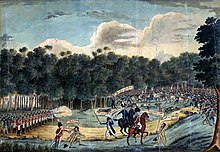Castle Hill Uprising
The Castle Hill Uprising occurred in 1804 in Castle Hill , a modern suburb of Sydney , Australia . It was the only rebellion in Australian history that ended bloody. The Irish convicts who rose against the authorities were defeated at the Battle of Vinegar Hill on March 5, 1804 by the New South Wales Corps using firearms. Numerous rebels were killed in the process, a large number were flogged and about 30 of them were deported to the coal mines of a remote camp. Nine were executed, including the two Irish rebel leaders.
prehistory
The ideas of the French Revolution of 1776 and the American War of Independence of 1789 strengthened the Irish desire for freedom. The uprising against the English was bloodily suppressed on Vinegar Hill in Ireland in 1789. Numerous rebellious Irish were subsequently arrested by the English and sentenced to long-term deportation to the convict colony of Australia . On the ships that the Irish transported to Australia, their death rate was extremely high, sometimes up to 37 percent. About a quarter of the population of the convict colony, which then numbered about 5,000, were Irish. It was therefore not surprising that shortly after their arrival, starting in 1800, the first resistance to the British colonial government arose in Sydney . On March 4, 1804, a violent uprising broke out, the roots of which lie in the Irish Rebellion of 1798 .
Uprising and battle
The leaders of the rebels were Irish rebel Phillip Cunningham, a stonemason tasked with convicting the Castle Hill settlement, and William Johnston. There were already initial plans for a rebellion in February 1804, but because of the difficult coordination between the widely spaced settlements, no exact date has been set for the beginning. As a signal for the start of the rebellion, a fire should be set in Castle Hill, which should be visible as far as Parramatta and Sydney. This happened after sunset on March 4th when around 200 rebels had gathered around Castle Hill. The lack of armament for the rebels should come from the settlers' stocks. The procurement of weapons did not go as hoped, however, because afterwards only one in ten rebels had a firearm, all the others only had axes and stabbing weapons. Then the rebel force was to march to Parramatta and on to Sydney . In this way their number would grow to 1,100 convicts, this is what the rebels hoped. The British learned of what was going on in Castle Hill and shortly before midnight the general alarm was triggered in Sydney.
On the morning of March 5, Major George Johnston of the New South Wales Corps led about 100 soldiers and horsemen to Parramatta. The force was split in half: Lieutenant Davies led about one half to Castle Hill and Major Johnston the other to Toongabbie, where the rebels were staying. Major Johnston reached about 250 rebels on the ridge that was later named Vinegar Hill . He and a Catholic priest wanted to negotiate with them, bloodshed should be avoided. When the rebels spotted more advancing soldiers, Major Johnston and the cavalryman Anlezark took the initiative and kept the rebel leaders at bay with their handguns (see picture above). Then Major Georg Johnston gave the order to fire. Nine rebels fell instantly, others were wounded and seven captured. Then three more rebels were shot and 19 captured. The resistance died down and the rebels fled. Nine rebels were later executed, including leaders Phillip Cunningham and William Johnston. Numerous rebels were whipped or put in irons. About 30 of them were immediately deported to the remote Coal River outpost near Newport in the local coal mine.
Name and aftermath
The name of the battle in Australia is based on the bloody battle on Vinegar Hill in Ireland. The clash in Australia is often referred to as the Second Battle of Vinegar Hill . The Battle of Ireland took place outside Enniscorthy , County Wexford , Ireland on June 21, 1798 when over 15,000 English soldiers faced 20,000 Irish rebels. It led to the crushing suppression of the rebellion.
In Australia, the insurrection is the subject of history lessons in schools.
In the Castle Brook Memorial Park in Sydney's suburb Rouse Hill , a monument commemorates this event. It was set up in 1988.
For the 200th anniversary, there were events in Australia on this topic.
Individual evidence
- ^ Robert Hughes: The Fatal Shore, the Epic of Australia's founding . P. 190. Button. New York 1987. ISBN 0-394-50668-5
- ^ A b Anne-Maree Withaker: Castle Hill convict rebellion , from 2009, on dictionaryofsydney.org. Retrieved November 8, 2016
- ↑ Castle Hill uprising on myplace.edu.au. Retrieved November 8, 2016
- ^ The Battle of Vinegar Hill ( Memento June 15, 2006 in the Internet Archive ). Retrieved November 8, 2016
Coordinates: 33 ° 43 ′ 45.3 ″ S , 151 ° 0 ′ 14.5 ″ E
